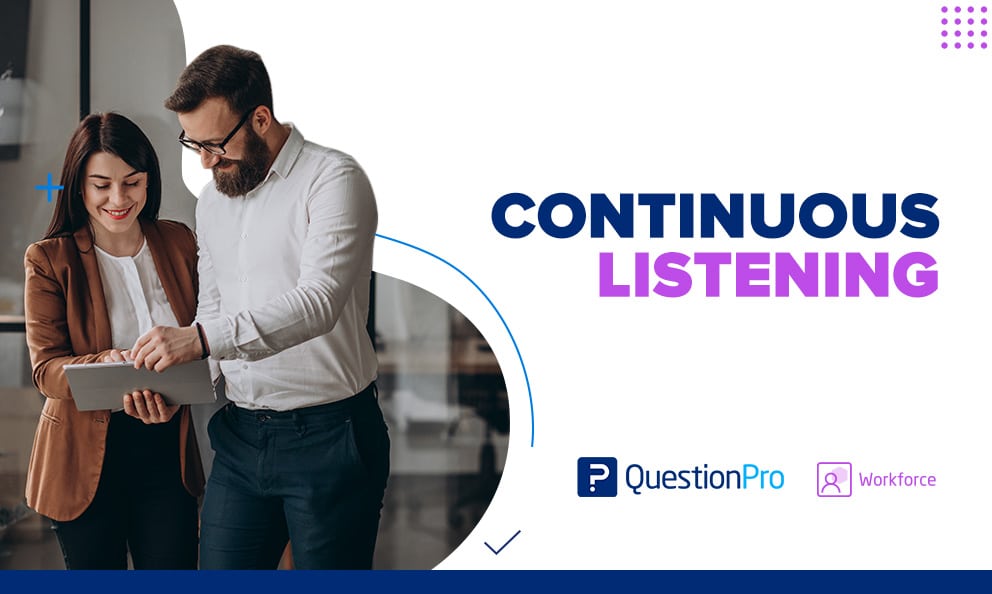
Part of any organization’s success is its ability to adapt to changing situations. The importance of giving your employees an opportunity to voice concerns and share recommendations has become remarkably clear, especially in recent years, where there have been many unknowns and employees seek clarity — and a path forward. So, how do you create this kind of commitment? By implementing a continuous listening strategy.
What is a continuous listening strategy?
Companies committed to their employee experience know they are not getting the complete picture if they sit and wait for feedback. A continuous listening strategy is all about having the resources and proactively getting continuous feedback on essential topics in your organization across the employee lifecycle, often collected on a large scale via employee surveys and performance reviews, to get valuable data.
Surveys as the foundation
An effective continuous listening strategy asks the right questions, to the right people, at the right time. To execute an effective continuous listening strategy, the company must have adequate resources to obtain valuable feedback. Some examples are an onboarding survey, a wellbeing survey, or various ways for managers, leaders, and HR to connect with their employees either on an individual basis or in small groups.
LEARN ABOUT: Employee Experience Strategy
Let’s start with surveys first. One way to prioritize what you want to know more about is by aligning the questions with your organizational values, mission, and where your organization wants to go. There are also emerging, common challenges across organizations, such as types of work arrangements, whether flexible, hybrid or otherwise, employee retention, creating a culture that doesn’t cause employee burnout, etc.. To get you started, here’s a list of survey topic that may suit your current objectives and employee strategy:
- Candidate Experience surveys
- Onboarding surveys
- Wellbeing surveys
- Diversity & Inclusion surveys
- Exit surveys
- Pulse surveys
- 360 feedback surveys
Employee surveys provide HR with powerful data to create more urgency for leaders to take action based on the most critical challenges identified. Many leaders across organizations are data-driven in other parts of their business, so the same strategy will work well in understanding the current state of their teams, and how they can measure the efforts they put in for improving the key areas or opportunities.
Manager check-ins
Managers can use employee survey data to guide conversations with their teams during their regular check-ins. Oftentimes in these meetings managers are likely to ask their employees how they are doing, receiving a “fine” response, and move on to more task-based conversations.
Using insights from employee surveys as a base, managers can ask more specific questions, such as “As you know, we recently ran a survey and we found out that people in our department feel overworked. This is really concerning as we want to make sure we have a healthy work environment.
Why don’t we review the projects you currently have assigned to make sure you have enough time and the right resources to deliver based on expectations?” This is just one of many examples of conversations that can be led based on data.
The most important part is that insights from surveys help managers better identify the key challenges so they can have a focused and constructive conversation with their team members about how to make smart improvements.
Continuous listening across the organization
In addition to meetings between employees and their managers, giving employees an opportunity to meet with leaders across the organization can be really powerful. Having a signup sheet where any employee can meet with any leader no matter the department or seniority is a really great way for employees to connect with those with who they usually may never cross paths within their daily work.
It provides a powerful opportunity for employees to share ideas and suggestions for areas that they are passionate about, with a leader who has the ability to make the fastest change.
This provides leaders with additional great ideas directly from their employees on ways to approach improvements that likely they would have never heard of. Having HR run a similar program themselves where employees can sign up to have conversations is another great way to shape a culture of continuous listening, where employees understand that their opinions and recommendations are extremely valuable to the organization.
One of the main benefits of implementing employee surveys is connecting with your employees during any meaningful moment in their experience and the organization’s life cycle.

Many organizations currently use surveys for the onboarding and exit process; the same process can be extended to other essential parts of the employee journey: recruitment and hiring, development, and retention.
While no strategy is one-size-fits-all in the corporate world, organizations must pay close attention to the tools they use to improve employee engagement, particularly in a world where hybrid, remote, and flexible working have become paramount.
Executing a continuous listening strategy
There are different ways to effectively listen to your employees, and choosing the best continuous listening strategy will depend on your organization’s needs, culture, and business strategy. No matter your overall strategy, employee surveys are just about always the best way to get started, because they will create an inviting and confidential space where employees can share their opinions, and arm you with the perfect foundation to build the rest of your listening strategy upon.
Learn more about how to get ongoing feedback from your employees and start taking action to make a positive impact in your organization with QuestionPro Workforce.









